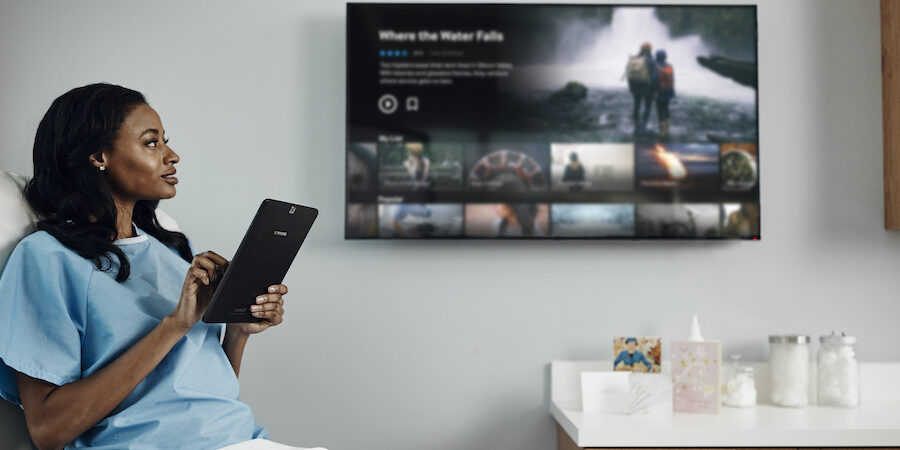The traditional hospital room is often inefficient for staff and frustrating for patients, thanks to its disparate technology and smudged whiteboards that display outdated information.
But that’s not the case for smart hospital rooms, which now have technology fully integrated, automated and streamlined — enhancing clinical workflows and efficiency by ensuring all information is current, accurate and appropriate for each team member. Not only do digital whiteboards update automatically with all relevant patient information, but patients can also use mobile solutions to adjust their room’s lighting, temperature and ambient noise, among other things. This strategic design improves the hospital experience by treating people as engaged guests — not passive patients.
How the smart hospital room enhances the patient-provider experience
These smart hospital rooms are already becoming a reality: Many hospitals are integrating streamlined tools and technology into their patient room design. Here are five ways the smart hospital room enhances the patient and provider experience.
1. Provide clear, current, correct information
The ubiquitous whiteboard is supposed to be updated every shift to include the names of the on-duty care team members, as well as the patient’s current health goals, dietary restrictions, medications and estimated date of discharge. But because this needs to be done manually, these boards are often out-of-date, inaccurate and illegible.
Digital whiteboards, such as Samsung QMC Series, update automatically based on integrated data streams, including the patient’s electronic health record (EHR) and staff scheduling software. Real-time location services (RTLS) integrated with digital displays can automatically tell patients the name and role of the staff member entering their room. Furthermore, the reliable, non-glare panels provide better visibility from all angles, any time of day — and without a single smudge or ink stain.
2. Prioritize patient safety
Integrated RTLS in digital displays also helps keep the patient safer. Digital signage outside the patient room door, for example, can keep staff and visitors informed of the patient’s allergies, preferred language and any safety precautions required to enter the room. Having this key information at a glance helps reduce errors and improve patient outcomes. This is enhanced when the information is updated automatically, noting any new changes and considerations.
3. Enable easy telehealth visits
Integrated cameras in the patient room support telehealth visits and remote patient monitoring. Clinicians and specialists can check in as needed without always needing to come to the patient’s room, and outside specialists can provide consultations without traveling to the facility. These tools also make it easy for patients to video call their family and friends, and access language translation services as needed.
Create the patient room of the future — today
Explore key technologies for enhancing patient experience and care while supporting staff. Download Now
4. Engage and entertain for a better experience
By providing patients with bedside mobile tablets and healthcare TVs, hospitals can help them stay engaged and entertained during their stay. In addition to improving the patient experience, these distractions can actually help reduce pain and anxiety. Plus, when patients are occupied, they’re less likely to call the nurses’ station, which means less alarm fatigue for staff.
5. Increase patient autonomy, decrease staff burden
In a smart patient room, patients can use tablets and other automatic room controls to make requests without sending an alert to the nurses’ station. For example, a request for a blanket or cup of ice chips can instead go to a certified nursing assistant or volunteer. Patients can also adjust the room’s temperature and lighting, control the window shades and even activate a white noise machine or relaxation audio to help them rest. With fewer nonmedical tasks to attend to, nurses can both find relief and energy to focus on more critical tasks, improving treatment and outcomes for their patients.
A better experience for all
In the hospital, smart room technology can improve the patient experience of care. It’s not just the right thing to do; it means higher scores in Hospital Consumer Assessment of Healthcare Providers and Systems surveys and lower long-term costs for hospital operations. Likewise, reducing the staff burden boosts morale, and by empowering everyone to work at the top of their license, hospitals see improved efficiency and better patient outcomes.
Discover the full lineup of Samsung healthcare TVs, manufactured with specific hospital TV features to improve the patient experience. And find out more about how hospital leaders can improve patient outcomes and facility resilience in this free guide.







